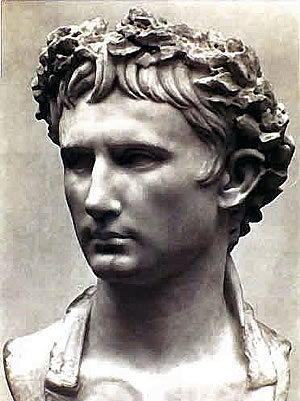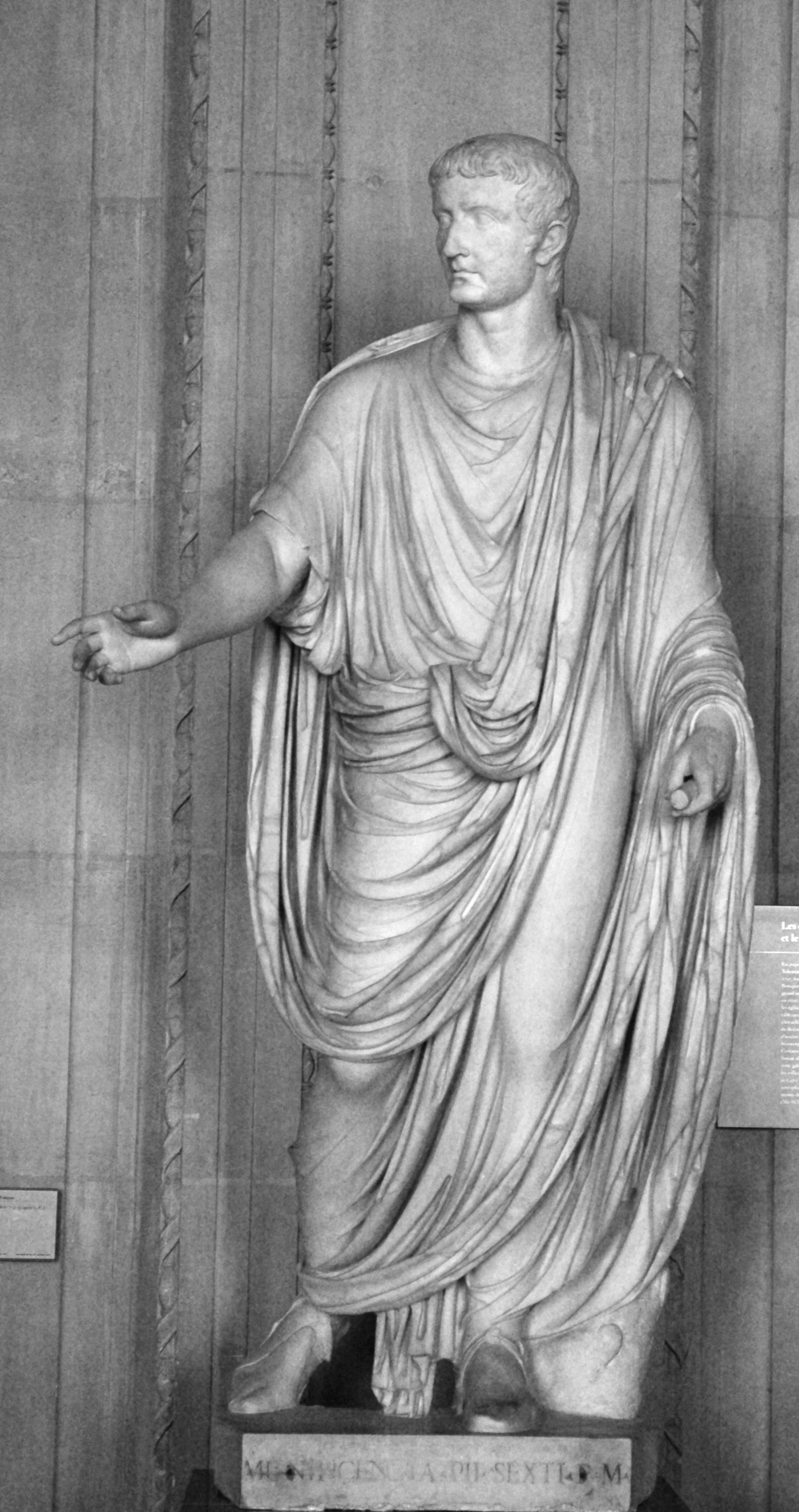|
Angusticlavia
In ancient Rome, an ''angusticlavia'', ''angusticlavus'', or ''angustus clavus'' was a narrow-strip tunic (''tunica'') with two narrow vertical Tyrian purple stripes (''clavi''). The tunic was typically worn under the toga with the right side stripe visible. Usage and significance The ''angusticlavia'' was the tunic associated with the rank and office of the ''eques'', or equestrians, one of the two highest legal orders in aristocratic Rome. Order members were military men, often patricians (''patrici''), who served as the cavalry units in war. During times of peace they frequently served as personal assistants to Roman senators. Equestrians wore the ''angusticlavia'' under the ''trabea'', a short toga of distinctive form and color. They also wore equestrian shoes ('' calcei''), and a gold ring ('' anulus aureus''). The tunic's stripes were about an inch wide, which contrasted with the senator's ''laticlavus'', which bore three-inch wide stripes. The ''angusticlavias purple-hued ... [...More Info...] [...Related Items...] OR: [Wikipedia] [Google] [Baidu] |
Tunic
A tunic is a garment for the body, usually simple in style, reaching from the shoulders to a length somewhere between the hips and the knees. The name derives from the Latin ''tunica'', the basic garment worn by both men and women in Ancient Rome, which in turn was based on earlier Greek garments that covered wearers' waists. Ancient era Indian tunic Indus valley civilization figurines depict both women and men wearing a tunic-like garment. A terracotta model called Lady of the spiked throne depicts two standing turban-wearing men wearing what appears to be a conical gown marked by a dense series of thin vertical incisions that might suggest stiffened cloth. A similar gold disc in the al-Sabah Collection from the Kuwait National Museum appears to be from the Indus Valley civilization depicts similar conical tunic-wearing men holding two bulls by their tails under a pipal tree shown in an Indus-like mirror symmetry. A mother goddess figurine from the National Museum new Delhi ... [...More Info...] [...Related Items...] OR: [Wikipedia] [Google] [Baidu] |
Equestrian Order
The ''equites'' (; literally "horse-" or "cavalrymen", though sometimes referred to as "knights" in English) constituted the second of the property-based classes of ancient Rome, ranking below the senatorial class. A member of the equestrian order was known as an ''eques'' (). Description During the Roman kingdom and the first century of the Roman Republic, legionary cavalry was recruited exclusively from the ranks of the patricians, who were expected to provide six ''centuriae'' of cavalry (300 horses for each consular legion). Around 400BC, 12 more ''centuriae'' of cavalry were established and these included non-patricians (plebeians). Around 300 BC the Samnite Wars obliged Rome to double the normal annual military levy from two to four legions, doubling the cavalry levy from 600 to 1,200 horses. Legionary cavalry started to recruit wealthier citizens from outside the 18 ''centuriae''. These new recruits came from the first class of commoners in the Centuriate Assembly org ... [...More Info...] [...Related Items...] OR: [Wikipedia] [Google] [Baidu] |
Egalitarianism
Egalitarianism (), or equalitarianism, is a school of thought within political philosophy that builds from the concept of social equality, prioritizing it for all people. Egalitarian doctrines are generally characterized by the idea that all humans are equal in fundamental worth or moral status. Egalitarianism is the doctrine that all citizens of a state should be accorded exactly equal rights. Egalitarian doctrines have motivated many modern social movements and ideas, including the Enlightenment, feminism, civil rights, and international human rights. The term ''egalitarianism'' has two distinct definitions in modern English, either as a political doctrine that all people should be treated as equals and have the same political, economic, social and civil rights, or as a social philosophy advocating the removal of economic inequalities among people, economic egalitarianism, or the decentralization of power. Sources define egalitarianism as equality reflecting the natural st ... [...More Info...] [...Related Items...] OR: [Wikipedia] [Google] [Baidu] |
Dresses
A dress (also known as a frock or a gown) is a garment traditionally worn by women or girls consisting of a skirt with an attached bodice (or a matching bodice giving the effect of a one-piece garment). It consists of a top piece that covers the torso and hangs down over the legs. A dress can be any one-piece garment containing a skirt of any length, and can be formal or casual. A dress can have sleeves, straps, or be held up with elastic around the chest, leaving the shoulders bare. Dresses also vary in color. The hemlines of dresses vary depending on modesty, weather, fashion or the personal taste of the wearer. Overview Dresses are outer garments made up of a bodice and a skirt and can be made in one or more pieces. Dresses are generally suitable for both formal wear and casual wear in the West for women and girls. Historically, dresses could also include other items of clothing such as corsets, kirtles, partlets, petticoats, smocks, and stomachers. History 11t ... [...More Info...] [...Related Items...] OR: [Wikipedia] [Google] [Baidu] |
History Of Clothing
The study of the history of clothing and textiles traces the development, use, and availability of clothing and textiles over human history. Clothing and textiles reflect the materials and technologies available in different civilizations at different times. The variety and distribution of clothing and textiles within a society reveal social customs and culture. The wearing of clothing is exclusively a human characteristic and is a feature of most human societies. There has always been some disagreement among scientists on when humans began wearing clothes, but studies involving the evolution of body lice suggest it started sometime around 170,000 years ago. Anthropologists believe that animal skins and vegetation were adapted into coverings as protection from cold, heat, and rain, especially as humans migrated to new climates. Textile history is almost as old as human civilization, and as time has passed, the history of textile has been more enriched. Silk weaving was introd ... [...More Info...] [...Related Items...] OR: [Wikipedia] [Google] [Baidu] |
Tribunus Angusticlavius
A ''tribunus angusticlavius'' ("narrow-striped tribune"; plural: ''tribuni angusticlavii'') was a senior military officer in the Roman legions during the late Roman Republic and the Principate. The ''tribunus angusticlavius'' was a junior military tribune who was at least 20 years old, chosen from among the Equestrian order, as opposed to the ''tribunus laticlavius'', who was chosen from the Senatorial class. There were five to each legion, identified by a narrow purple stripe (''angustus clavus'' or ''angusticlavus'') on their tunics. Despite their youth, the tribunes had previous experience, usually as a ''praefectus'' leading a quingenary auxiliary cohort. Their duties varied, mostly staff work, but also lead two cohorts. The next step of promotion was often as ''praefectus'' of a 500-strong cavalry ''ala Ala, ALA, Alaa or Alae may refer to: Places * Ala, Hiiu County, Estonia, a village * Ala, Valga County, Estonia, a village * Ala, Alappuzha, Kerala, India, a village * Ala ... [...More Info...] [...Related Items...] OR: [Wikipedia] [Google] [Baidu] |
Laticlavus
In Ancient Roman regalia, a ''laticlave'', or ''clavus'', was a broad stripe or band of purple on the fore part of the tunic, worn by senators as an emblem of office. The name ''laticlavia'' translates to "broad nail" and figuratively "broad stripe", in contrast to the "narrow stripe" (''angusticlavia'') which appeared on the tunics of lower social ranks. This ornament, according to some, was called ''clavus'' ("nail") as being set with little round plates of gold, or silver, like the heads of nails. Cantelius maintained that the clavus consisted of a kind of purple flowers, sewn upon the cloth. The garment is mentioned in Suetonius, as citizens singing songs of disapproval against Julius Caesar Gaius Julius Caesar (; ; 12 July 100 BC – 15 March 44 BC), was a Roman general and statesman. A member of the First Triumvirate, Caesar led the Roman armies in the Gallic Wars before defeating his political rival Pompey in a civil war, and ... for him having offered the opportuni ... [...More Info...] [...Related Items...] OR: [Wikipedia] [Google] [Baidu] |
Clothing In Ancient Rome
Clothing in ancient Rome generally comprised a short-sleeved or sleeveless, knee-length tunic for men and boys, and a longer, usually sleeved tunic for women and girls. On formal occasions, adult male citizens could wear a woolen toga, draped over their tunic, and married citizen women wore a woolen mantle, known as a palla, over a stola, a simple, long-sleeved, voluminous garment that hung to midstep. Clothing, footwear and accoutrements identified gender, status, rank and social class. This was especially apparent in the distinctive, privileged official dress of magistrates, priesthoods and the military. The toga was considered Rome's "national costume," privileged to Roman citizens but for day-to-day activities most Romans preferred more casual, practical and comfortable clothing; the tunic, in various forms, was the basic garment for all classes, both sexes and most occupations. It was usually made of linen, and was augmented as necessary with underwear, or with various ki ... [...More Info...] [...Related Items...] OR: [Wikipedia] [Google] [Baidu] |
Clavus
Clavus may refer to: * Claudius Clavus (born 1388), 15th-century Danish cartographer * ''Clavus'' (gastropod), a genus of snails in the family Drilliidae * The Roman ''clavus'', a reddish-purple stripe on garments that distinguished members of the senatorial and equestrian orders; see laticlave and angusticlavia * A shooting pain in the forehead, associated with hysteria, also called ''clavus hystericus'' * Corn (medicine), type of callus formed on the toes * The plant disease ergot * The pseudo-tail of the Molidae (sunfish) * In Hemiptera, a usually narrow strip of the hemelytron An elytron (; ; , ) is a modified, hardened forewing of beetles (Coleoptera), though a few of the true bugs ( Hemiptera) such as the family Schizopteridae are extremely similar; in true bugs, the forewings are called hemelytra (sometimes altern ... adjacent to the scutellum See also * Clav (other) {{disambiguation ... [...More Info...] [...Related Items...] OR: [Wikipedia] [Google] [Baidu] |
Roman Consul
A consul held the highest elected political office of the Roman Republic ( to 27 BC), and ancient Romans considered the consulship the second-highest level of the ''cursus honorum'' (an ascending sequence of public offices to which politicians aspired) after that of the censor. Each year, the Centuriate Assembly elected two consuls to serve jointly for a one-year term. The consuls alternated in holding '' fasces'' – taking turns leading – each month when both were in Rome and a consul's ''imperium'' extended over Rome and all its provinces. There were two consuls in order to create a check on the power of any individual citizen in accordance with the republican belief that the powers of the former kings of Rome should be spread out into multiple offices. To that end, each consul could veto the actions of the other consul. After the establishment of the Empire (27 BC), the consuls became mere symbolic representatives of Rome's republican heritage and held very little ... [...More Info...] [...Related Items...] OR: [Wikipedia] [Google] [Baidu] |




